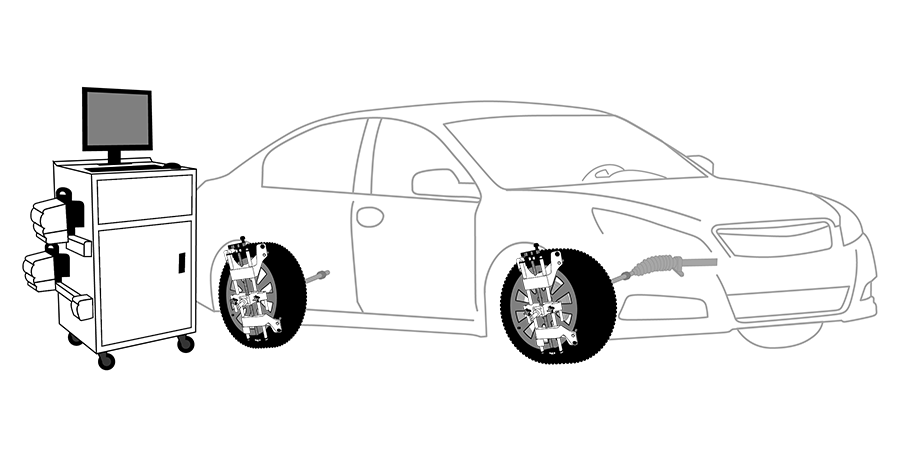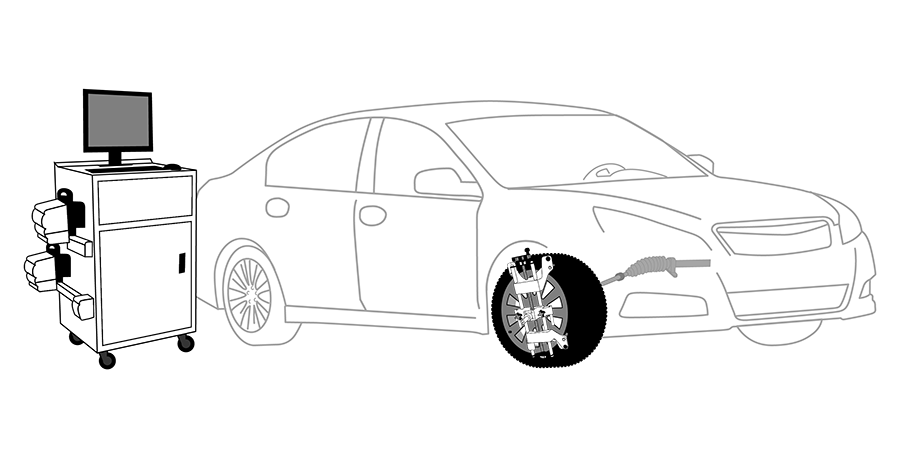Wheel Alignment
Why wheel alignments are important
A wheel alignment consists of adjusting the wheels of your vehicle so that all wheels are parallel to each other and perpendicular to the ground. Three basic angles contribute to proper wheel alignment: camber, caster, and toe. Camber is the measure of the degree of perpendicular offset from the road surface. Caster is the angle of your wheel’s pivot, which is attached to the suspension, and when this angle is out of alignment, straight-line tracking is affected. Toe refers to the angle of directional difference between the tire and the centerline of the vehicle. The front and rear wheels on your vehicle should always be perpendicular to the ground and parallel to the tire beside it. Routine wheel alignments have the potential to save you money in the long run while promoting optimal vehicle performance.

Four-Wheel Alignment
Wheel alignments help ensure your tires are angled correctly—level with the ground, pointing straight ahead, and parallel to each other—so they can maintain straight-line tracking. Proper alignment angles will help you maximize the life of your tires. In addition, the handling of your vehicle will be considerably easier. Wheel alignments are arguably the most important aspect of wheel and tire maintenance. Three angles promote proper wheel alignment: toe, caster, and camber. Toe is the measurement between tires. Your tires should be in equal positions and parallel to each other. Caster, or the angle of the steering pivot, permits the wheels to turn along with the steering wheel. Camber is the angle of the wheel, which should be perpendicular to the ground. Four-wheel alignments are an important part of extending the life of your tires, because misaligned tires inevitably lead to poor tire performance and uneven tread wear.
Two-Wheel Alignment
Wheel alignments are a particularly important step in overall tire and wheel maintenance. The purpose of a wheel alignment is to ensure your tires are pointing straight ahead, perpendicular to the ground, and parallel to each other so they roll at the right angle. Properly aligned tires will help you get the most out of your tires, and vehicle handling will feel considerably easier. When it comes to wheel alignment, three angles contribute to proper alignment: camber, caster, and toe. Camber is the angle of the wheel, which should be at 0° in order for the tire to be perpendicular to the ground and not cause uneven wear to the outer edges. Caster is the angle of the steering pivot, which allows the tires to turn with the steering wheel. Toe is the measurement between tires so that they are parallel to each other. Keeping all three angles in sync will provide for better performance.

Benefits of Wheel Alignment
A wheel alignment will keep your vehicle running safely and efficiently by promoting reduced tire wear, better gas mileage, and safer driving conditions. Wheels out of alignment will contribute to uneven tire wear. Uneven tread wear can be felt in a vehicle pulling to the right or left while in motion. Left untreated, wheel alignment issues have the potential to turn into steering and suspension issues, since driving with wheels out of alignment not only puts stress on your tires but also on suspension components. If your vehicle begins pulling to the right or left while driving, or if you feel a vibration in the steering wheel at higher speeds, contact us today for a wheel alignment service.
Morgan Automotive proudly serves the Wheel Alignment needs of customers in Durham, NC, Morrisville, NC, Cary, NC, and surrounding areas.
Areas Served : Durham, NC | Morrisville, NC | Cary, NC | and surrounding areas



